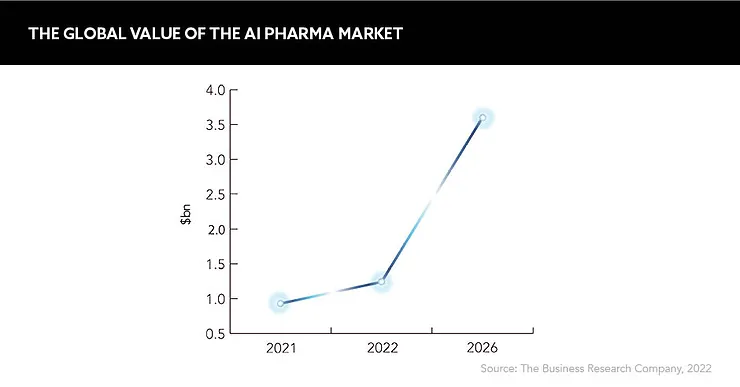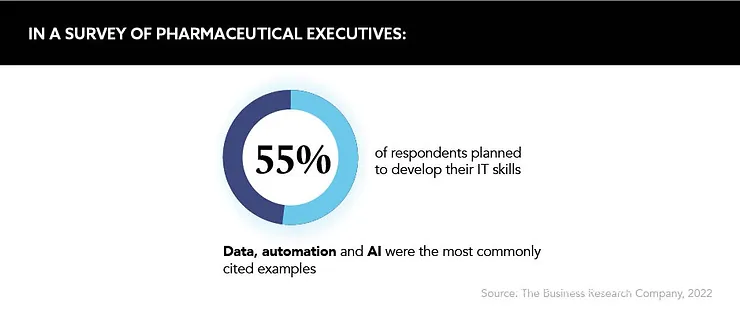The likes of Amazon, Netflix and Google have taken digital innovation to an entirely new level. Now, the pharmaceutical industry must move with the times to meet growing patient needs and expectations. What can pharma learn from the tech giants, and what might the future have in store?
Words by Jade Williams
When it comes to digital innovation, tech giants stand far and above any other industry. The likes of Amazon, Netflix, Apple and Google have optimised processes and elevated user experience beyond consumer expectations and facilitated the modern lifestyle we have all come to enjoy – giving us the products we never knew we needed but now cannot live without. It’s safe to say that the digital innovation bar has been set very high.
While pharmaceutical products and therapies are also deeply ingrained necessities within society, particularly among the ageing populations seen in many countries across the world, pharma’s product output operates on a strictly need-to-have basis rather than being rooted in aspiration. This, combined with relatively slow progress in digital transformation, has meant pharma has struggled to make innovation headway and risks falling behind the curve.
The overall business models of pharma companies and tech giants clearly differ, and direct comparisons cannot be made, but there’s still much that pharma can learn from its direct-to-consumer, technologically minded counterparts. Ultimately, the convergence of tech and pharma is inevitable, and pharma companies must evolve to meet the needs customers have grown to expect. Tech giants are doing digital right – and so too can pharma.
Dealing with digital inertia
Digital has started to change how pharma operates, particularly as a result of the COVID-19 pandemic. Key techniques have made their way from large tech corporations into the pharma space over the last few years, with most corporations adopting software such as Amazon Workspace or Microsoft Teams to streamline their business processes.
However, the industry is still far behind others in the digital stakes and there is much more progress to be made. José Maria Guido Avila, Customer Engagement Transformation Lead, Sanofi Genzyme, comments: “The pharma industry has invested in learning techniques like SCRUM for product development, however they have struggled with resistance from ‘old pharma’ marketers who do not believe this will add value and instead see it as a fanciful activity.”
Pharma has struggled to make innovation headway and risks falling behind the curve
For some, this resistance drags innovation back to the drawing board in pharma, whereas for large tech companies, investing in whizzy tools such as this is something to be embraced. If pharma hopes to stand on a level playing field with the technological masters, Yigal Aviv, Patient and Healthcare Experience Lead, Pfizer, claims that “pharma companies must innovate from the ground up, looking inside themselves first at what they can improve”, and project management solutions could be one advantageous starting point.
The journey and the destination
Adopting and building upon tried and tested techniques from tech giants is key in sending pharma’s digital innovation to new heights. Still, customer experience is everything to these tech behemoths, and they do not excel by simply creating pockets of winning innovation. Nailing the overall customer journey is integral to their success.
“Take Amazon for example,” notes Guido Avila. “They have a very clear definition of the user journey from acquisition to conversion, and they strive to reduce the stress points across that journey so that every purchase is a more seamless experience than the previous.” Starting with a pain point rather than a solution is a sure-fire way to ensure customers are truly benefitting from new innovation efforts.
Pharma companies must innovate from the ground up, looking inside themselves first at what they can improve
“Amazon used the data from its customers and analysed how they behave,” continues Guido Avila, “and then through experimentation learned the best way to provide the optimal experience to their customers, unlike pharma, which frequently carries out market research to come up with the same insights and cliché results.” It’s this learning opportunity – understanding the importance of continuous customer analysis and experimentation – that holds particular value.
A mindset shift is clearly required, and Konrad Dobschuetz, National Director NHS Innovation Accelerator & Chief Enterprise Officer UCL Partners, recommends being forward thinking when devising new strategies for specific pain points. One technique he’s utilised successfully is publishing a “focused press release announcing the launch of a product in three to four years as a lighthouse you can steer towards”. His innovation team then works backwards from this end goal, devising a well-thought-out strategy to achieve its objectives every step of the way, using the initial press release as a way to hold themselves accountable.

Set the bar high
When devising innovative methods to engage customers, teams must remember that HCPs and patients are people, too. Tech giants seem to be piloted to an ultrahuman degree, and their well-oiled machines mean they understand how their customers think and therefore have a benchmark for approaching intuitive design.
When using any service, “the last best experience you had becomes your expectation for your next experience”, Guido Avila notes. “If patients and HCPs are having good customer experiences on Amazon, Netflix and Google, those expectations are being extrapolated to pharma.” There is certainly an expectation in this technological era that all respectable services should have an easy-to-use platform, and pharma should prioritise this during development.
The last best experience you had becomes your expectation for your next experience
The dating app Tinder offers a surprising example of how pharma can reach its goals, according to Aviv. On the app, hopeful singles swipe right if they are interested in a potential partner and left if not. Aviv suggests pharma companies harness simple, user-friendly technology such as this to enable patients to report on their conditions. Creating adverse event reporting tools for patients to easily flag issues, or opening review forums could all be achieved very simply. In this way, patients would have an accessible platform on which to be heard and make choices, while also providing quantifiable statistics to pharma companies.
Learning from the tech masters
It’s not just the tech that forms a successful foundation for innovation – digital or otherwise – and there are plenty more examples of working ideologies that pharma can adopt from tech giants, especially when it comes to leadership and company culture.
The CEOs behind large tech corporations are recognisable the world over. The likes of Jeff Bezos, Elon Musk, Mark Zuckerberg and the late Steve Jobs are all well-polished public entities, garnering respect and ridicule to varying degrees. Love them or loathe them, they are undeniably skilled at creating work cultures where innovation can thrive due to their often-eccentric philosophies.
Dobschuetz reflects upon one of Bezos’ management methodologies at Amazon, stating: “Bezos urges staff to treat every day at work as their first day, and through this philosophy they remain curious.” This encourages staff to keep questioning the processes in place, and these inquisitive mindsets breed a successful environment for innovation – echoing Aviv’s earlier philosophy of innovating from the ground up.
Musk’s take on leadership in the early days of Tesla in the US is also a prime example, according to Dobschuetz. “Musk slept in the production plant so he could be there from 6am working through the problems his employees were facing,” he says. While this may not feasible for all company CEOs, “Musk really managed the transition to be seen as a leader,” Dobschuetz continues. Getting stuck in with staff can enable CEOs to become inspirational leaders by raising motivation and gaining new perspectives from those putting in the groundwork.
While pharma is moving in leaps and bounds to reach the successes of its technological counterparts, and lots of good is coming from the tech industry, pharma should not place tech giants on an entirely positive pedestal. It is no secret that companies such as Meta don’t have glittering reputations, stemming from data privacy concerns and, at times, questionable leadership decisions. Dobschuetz notes that “no one really trusts Facebook”, adding that “you don’t have that level of a firewall in between the company and the consumer, so we all know that they’re tracking our data constantly. It’s nice to have that division in pharma.”
Pharma is continuing on its long digital innovation journey, and while there’s still a lot to learn from the astute tech giants of this world, perhaps there’s something tech can learn from pharma, too.

Competition vs collaboration
There are many questions arising in the industry as to whether pharma is under threat from big tech companies moving into its space. But, taking a step back and considering the bigger picture, is this an opportunity for competition or collaboration?
Samsung Biologics, Google Quantum AI and Microsoft are just three of the companies venturing into the healthcare and pharma spaces, with many of the big pharma players, such as GSK, Sanofi, Boehringer Ingelheim and Novartis partnering with them to further their R&D efforts and efficiencies, among other activities.
Indeed, Yigal Aviv, Patient and Healthcare Experience Lead, Pfizer, champions this cross-sector working, stating: “There are opportunities for both pharma and tech to pool their resources together to find solutions to some of the most pressing healthcare issues of today. Pharma are the drug development experts, and tech giants may find it difficult to go it alone in such highly regulated and complex industries.”
Allaying fears about direct competition for pharma, Konrad Dobschuetz, Head of Digital Innovation, Customer Solutions and BIOME Lead UK, Novartis, simply states: “If companies like Amazon and Apple had seen any key or commercial benefit in entering the pharma market, they would have done so already.” He believes that a better future for pharma and tech comes in ‘bring your own device’ or BYOD clinical trials, in which the likes of Apple and Samsung can optimise patient experiences by supplying pharma companies with handheld devices for remote patient monitoring, saving time, money and emissions from clinical trials.
And José Maria Guido Avila, Customer Engagement Transformation Lead, Sanofi Genzyme, is in agreement when it comes to the benefits for clinical trials, particularly around recruitment and RWE generation. “While the pharma industry is focused on treating diseases and selling treatments, tech giants are thinking about healthcare as rather a means of solving patient needs and obtaining data,” he explains. “Here, for example, Google could offer support for the identification of patients and connect them to get access to a clinical trial if they are suitable candidates, or we could use ‘synthetic data’ to inform RWE studies.”
And the potential for data doesn’t end there. “It’s about finding a way to use the data [tech companies] have about customers in a compliant way so that it can be used for earlier diagnosis, to improve access to treatments or, ultimately, to allow for precision medicine or personalised medicine. I believe this is possible if we tap into the potential of data collection they have and their algorithms,” Guido Avila concludes, highlighting that collaboration is undoubtedly the key to success.









